Are you starting out each new marketing job by searching through a sea of endless files? If your marketing workflow needs a fair bit of neatening, streamlining, and all-round harmonizing, we have a strategy in mind that will do just the trick.
Brand asset management (BAM) is about more than choosing an attractive color scheme. It requires taking on a holistic approach to your company’s entire branding by utilizing strict organization and employing the necessary tools to ensure that it’s a success (wherever your consumers see it). Brand consistency is essential for higher brand awareness amongst your consumers, and it’s ultimately necessary for ensuring continued growth for your business.
In this article, we’ll be guiding you through the best practices to get started with managing your product brand assets and creating a BAM strategy that perfectly suits your business.
What is brand asset management?
Before we look into brand asset management, it’s important to establish the basics. Or, in other words, define brand assets.
Brand assets are all the symbols that make up your brand identity and make your brand recognizable to your audience. This includes, documents, visuals, or different images that you use when creating your marketing content. All with one goal in mind – to maintain brand consistency and make your brand stand out from your competitors.
Here are different examples of brand assets:
- Your brand name
- Your logo (and all of its adaptations for different platforms and uses)
- Advert designs and social media artwork
- Images (including photos, illustrations, and graphics)
- Biographies on your website
- The typography and fonts you use
- Any taglines or slogans
- Materials for your communications (such as business cards, press release templates, or letterheads, which can either be in print or via email)
- Brand assets also include guidelines that ensure the correct usage of your branding
BAM is all about treating your company’s branding as an asset in and of itself, in order to protect it (as you would protect an expensive computer). BAM is an organizational practice that uses dedicated software to help your entire team easily access and edit all your digital assets.
Difference between digital asset management (DAM) and brand asset management (BAM)
BAM is the brainchild of the systems of digital asset management (DAM) and brand management, and it has inherited the most useful traits of both parents. BAM gives your team the tools to create a storage space for your brand assets. In this space, you can collaboratively create branded content.
On the other hand, DAM is all about your digital presence and digital strategies (e.g., your website). It focuses on the way your team can store, organize, and access all digital business. Users can then keep track of these resources by protecting them from loss, theft, or incorrect usage.
BAM applies this same principle to assets that specifically focus on your brand. BAM’s storage functionality comes from the basis of DAM, and both techniques help users achieve better online asset management by creating a more efficient marketing workflow
How can your team benefit from digital brand asset management?
BAM tools are key to successful business growth. They keep your workflow streamlined, communication effective, and work productive—while continuing to keep your company’s signature branding unique and effective.
By incorporating a digital BAM strategy into your business, you can create a central, purpose-built, cloud-based location. From this location, all of your brand assets can be safely stored, accessed, and distributed across your team. This organization reaps rewards in itself. A recent study by CoSchedule found that marketers who are well-organized are 397% more likely to classify themselves as successful.
You can also ensure that only the most recent, up-to-date content versions are being used, and you can properly govern your marketing to ensure that it’s consistent and stays firmly on-brand. BAM necessitates a more advanced consideration of your branding across all of your different marketing strategies and platforms
To best suit each of these platforms, your branding should be able to slightly adapt, yet clearly remain interconnected and true to the original. “Why?” you ask. A Lucidpress study found that consistent presentation of a brand has been shown to increase revenues by 33%.
Throughout all of your wide variety of marketing materials, it is essential for your brand to adhere to these governing principles. A recent study found that when a customer visits your website, it will take them just 50 milliseconds (0.05 seconds) to form an opinion about it. Keeping your branding consistent and high-quality is the crux of keeping your brand recognizable and credible.
Here are some of the benefits of incorporating a clear BAM strategy into your business:
- Organizing your brand assets in far better ways
- Improving your efficiency and organization
- Monitoring the lifecycle of your brand assets and ensuring that fully up-to-date versions of each brand asset are readily available
- Improving team communication and collaboration on marketing projects
- Enhancing your brand consistency and representation
- Enabling you to easily develop, manage, adapt, and improve your brand
- Enforcing clear, strict brand guidelines that keep your brand consistent and maintain clear integrity throughout all elements of your business materials
- Ensuring that your branding retains its authenticity and uniqueness, which will help make it stand out in the market, appeal to consumers, and ultimately create a higher level of brand awareness. (These benefits will translate into more sales and a stronger sense of loyalty from your customers.)
Conducting BAM is an easy strategy that will enable you to better appeal to the core users of your brand and make sure that you are successfully targeting their interests through your promotional activities.
Four steps for building a solid brand asset management strategy
In order to set up clear, rigid brand guidelines that will dictate the ways your consumers see your brand and ensure it consistently maintains a strong presentation, you need to build a solid BAM strategy.
Use dedicated BAM software to provide a centralized hub. From there, you can store, manage, and update all of your brand assets. Below, we’ve created a step-by-step guide that allows you to create a strategy that’s perfectly suited to your own company.

#1 Select the assets you wish to store
Begin with a thorough audit of your current brand assets. Keep a detailed account of what you currently have, where everything can be found, and whether they conform to your most current branding.
Select the files that:
- Are necessary for your entire team to have access to.
- You use most regularly (e.g., key logos or photographs)
- You would find it useful to have easy access to, or the entire team would benefit from having readily available for collaborative projects.
- Are the most up-do-date versions of all of these assets.
#2 Organize your folders, sections, and various subsections
Once you’ve decided on which assets to include, the next step is to use your BAM software to create a central location to store them all.
This step should have clear subcategories that are easy to navigate—in a clear, logical system of folders. Users can then quickly and easily search for the resource they need.
The best way to complete this step would be to:
- Map out a simple hierarchical structure for your folders that’s easy to follow. (This structure could start out with a folder specifically dedicated to each team. This folder should contain subfolders that denote the types of assets within them, as well as folders within those subfolders to further separate different asset types.)
- Ensure that all of your folders and files have clear titles. Then users can easily search for a particular resource.
You can also use advanced, sophisticated tagging options across your different assets. This tactic will ensure that any user can easily find them without having to duplicate them across other folders.
#3 Look for any gaps in your current assets
Now that you know what you have and where to find it, you can start thinking about what else you need to complete your collection of brand assets.
From email headers to Instagram logos, you need to identify what you’re missing, and record what you need to create to successfully fully implement your BAM strategy. Also speak to your team, and find out which additions they think would be useful.
Furthermore, for the assets you’ve just organized, you need to establish a clear system that will help you continue this process of cataloguing in the same coherent manner. This process should also include controls like revision dates and information pertaining to the life cycles of each of these assets.
#4 Develop clear guidance and an outline for usage of your business branding
After all of these key features are in place, you want to make sure you solidify all of this good work and ensure that it has a lasting impact.
Create a set guideline for your branding and cover all of your bases, including detailed instructions for controlling elements such as color palettes, the positioning of images and logos, target marketing, and the phrasing of your content. You also need a clear approval process that all new assets need to go through, in order to be used in your marketing materials. This system will greatly assist your business’ marketing project management process, too.
Using a content proofing software (such as ) can help you streamline your review and approval process for all of your brand assets.
Three great examples of successful brand asset management
Eager to get started? Or are you still unsure whether this tactic is the best way to go about investing your time as a business? For those of you who aren’t quite sold on this idea, here are three fantastic case studies. These businesses were able to reap brilliant rewards by introducing strong BAM strategies to their businesses.
1. Frontify – MAN Truck & Bus AG – Establishing a centralized system
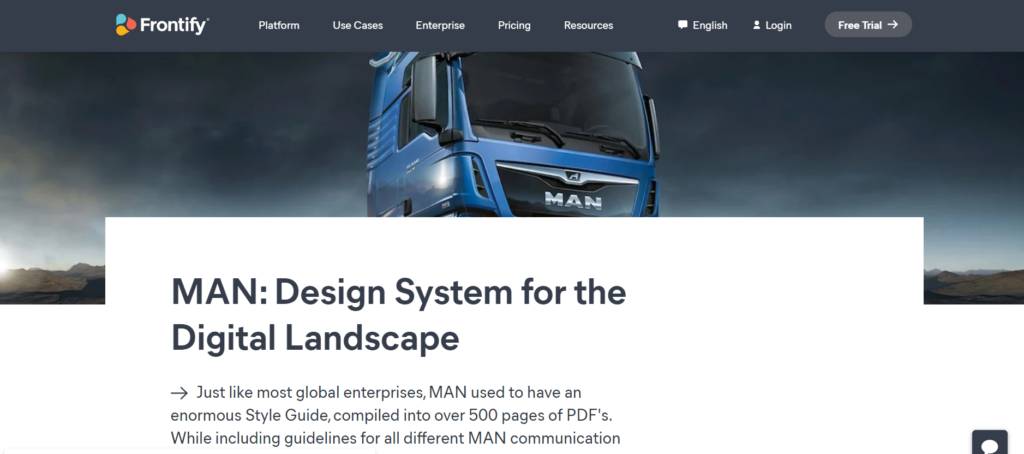
Back in 2016, MAN Truck & Bus AG wanted to use a clear BAM strategy and be ready for the relaunch of their digital channels. But since their global team was split across 60 different countries, this strategy wasn’t going to be easy to implement.
Prior to the introduction of their BAM strategy, MAN used to have to negotiate between their graphic designers and developers. Each individual had to manage locally designed, different versions and updates of these brand assets (which was a logistical nightmare).
But after they established their BAM strategy for managing brand assets, they were able to use the cloud and keep the entire team working well across the designs of these assets (in accordance with their strict new style guide). And they sustained this collaboration throughout the entire project—by using this centralized platform for all of their branding, coding, and design.
2. Bynder – Klarna – Maintaining brand consistency and customer loyalty
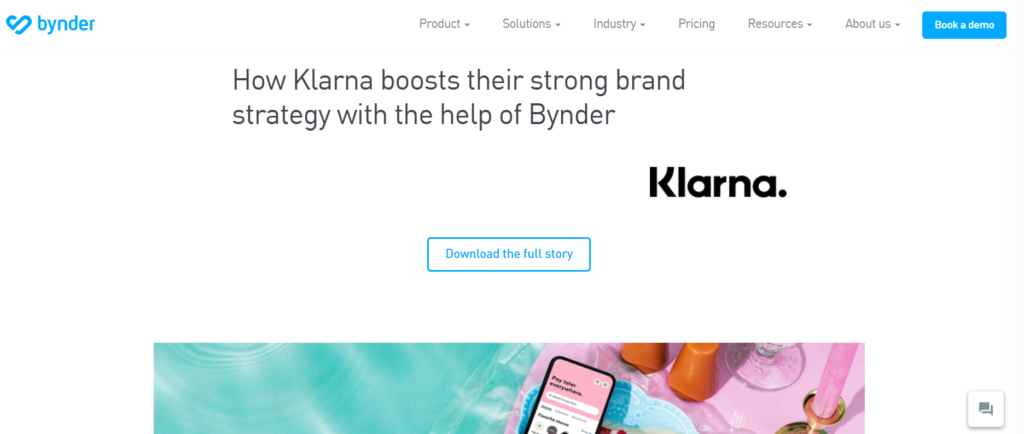
When Klarna used Bynder to implement their new BAM strategy, they were able to use competitive differentiation to assert their position and unique company strengths in the marketplace.
For Klarna, trying to maintain the loyalty of its 130,000 merchants was no small matter. They found that they were struggling to maintain their rapid growth, given the need to keep their brand value and identity true to their original ethos. Amidst the company’s rapid growth, they developed a widespread global team, and they struggled to control the branding they had created.
In order to minimize these inconsistencies amongst their brand assets, Klarna introduced BAM software that enabled universal access to the most correct and recent versions of their brand assets, alongside clear brand guidelines. With these BAM tools, Klarna successfully did a brand refresh in just two weeks, and they updated their brand assets in a universal, consistent, and effective way across the world, in order to connect with their customers and ensure that their brand could scale at the same rapid rate.
3. Widen Collective – Trunk Club – Improving efficiency and boosting brand equity
Trunk Club is another business that’s experiencing rapid growth. But there was a period when their growth was threatened because they slacked off with the quality of their brand assets.
As a key part of their marketing strategy, Trunk Club holds a huge number of product shoots and generates new images every single day. Their previous disorganization led to trouble for the marketing and stylist teams when they were trying to choose good imagery to use.
Instead of being able to easily select beautiful product images that would support their efforts, they increasingly found that these images were hard to locate. For instance, they often lost or deleted key shots. And they wasted time because they had to stage entire reshoots and reedits. Also, poor-quality, outdated, and brand-damaging images were persistent problems, as they accidentally shared these images with their consumers.
But with the implementation of a fantastic BAM strategy, the Trunk Club now has a centralized bank of all of their brand assets. Users can easily search this bank and find a key image. Plus, these assets are the most up-to-date and desirable versions, which saves them time, stress, and inconsistencies.
Best brand asset management software on the market
Finding the right brand asset management software can be a tricky task. We all have specific needs and processes, and it’s crucial to find a solution that reflects that.
Here are some of the leading brand asset management systems together with their key features:
1. Filestage
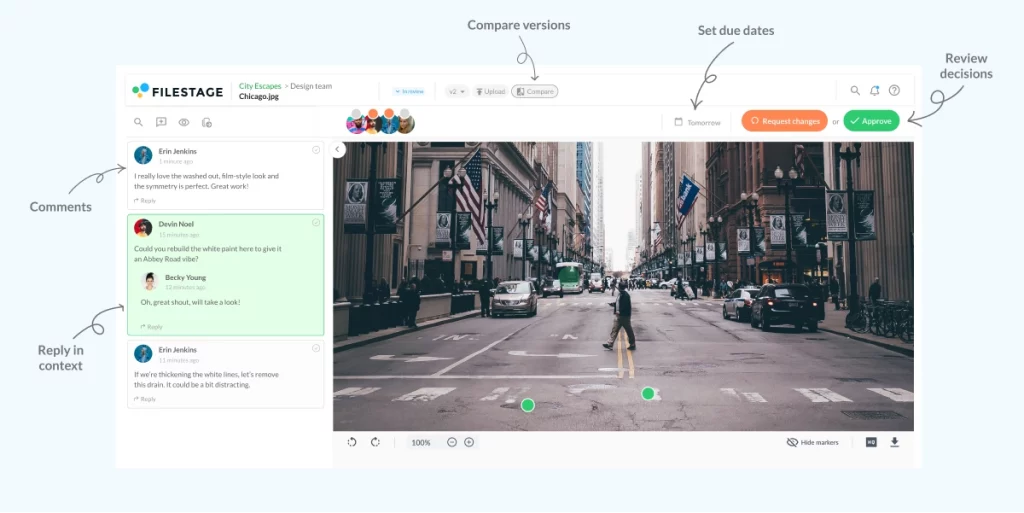
Filestage is predominantly a brand asset review software. However, it can also be used as a tool to manage and archive assets. It is a collaborative platform that helps facilitate BAM strategies by making proofing and approval processes far easier to conduct —across a team and alongside internal or external stakeholders.
Filestage is designed to provide flexibility and meet the needs of various DAM and BAM tools. This brand asset management platform is best-suited for marketing teams and media companies. It’s designed to help make joint access to a single file easier and remove the need for collaboration via email.
Manage every approval in one place
Request approval without sending a single email with Filestage.
2. Papirfly

Papirfly is a cloud-based brand management platform designed for marketing teams. The tool makes it easy to share, collect and distribute your digital assets all in one place.
Papirfly offers multiple tools that support your team in the management of your branded content. The brand hub allows you to easily find the assets you are looking for, while the digital asset management function helps you to organize all your media files.
With the Template Studio your team can provide pre-designed templates which helps to set a design standard across your company. The Marketing Planner helps to organize and coordinate global, national and local marketing activities. As you can see, this brand asset management system has a lot of helpful tools that your team can use to manage your branded assets more efficiently.
3. Frontify

Frontify provides an all-in-one cloud-based brand management platform. It upgrades the standard DAM software, which provides the key tools for a BAM strategy. It also facilitates a platform for cross-collaboration across all of your teams, which makes everyday marketing and brand design strategies far more streamlined. So it helps keep your branding consistent throughout all channels.
Frontify provides a BAM solution that’s aimed at all industries, and it has a number of different channels to manage. But it’s ideally suited for companies at an Enterprise level.
4. Brandkit
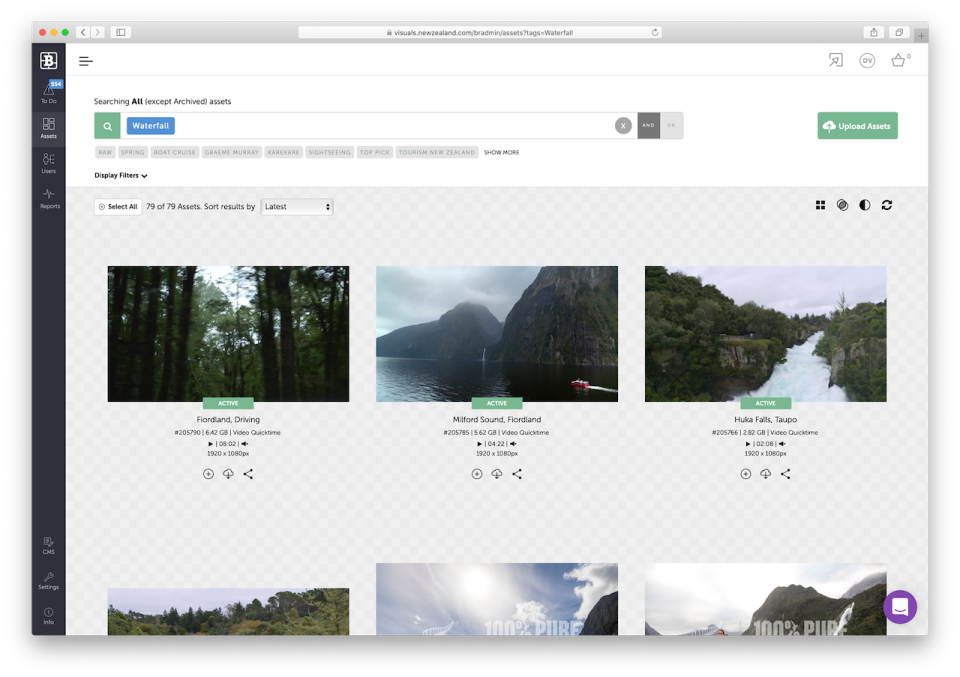
Brandkit combines traditional DAM software with a brand-centric approach. It provides a single, organized, flexible, and user-friendly centralized platform for all of your digital marketing content, which your whole marketing team can access.
From there, it offers a variety of file-sharing options, including shared collections/lightboxes, built-in sending that’s similar to WeTransfer, a self-service brand portal, and RSS image feeds.
Brandkit can accommodate all sizes of marketing teams, as it has a very content-oriented approach to marketing.
5. Bynder

Bynder is designed to provide an easy option for professional DAM. It also provides a software solution for your BAM strategy, as it enables teams to undertake real-time collaborative edits of your branding and marketing materials.
It also provides easy file-sharing, secure storage, and auto-formatting tools—all in one central cloud-based platform.
Bynder is a software solution suited to a range of companies and teams. It’s designed to assist with the day-to-day operations of marketing departments, brand managers, consultants, communications departments, and agencies (including press, design, and creative).
6. Brandworkz
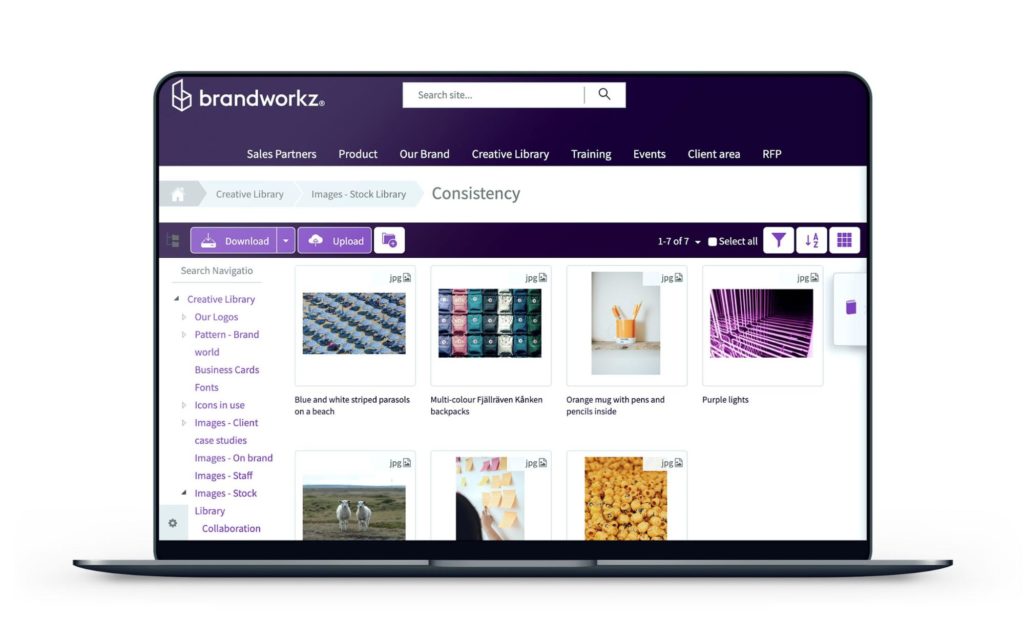
Brandworkz is a BAM solution that focuses on helping companies achieve brand consistency. It’s used by major brand names, such as Aon, Dr. Martens, and NBCU. It enables your branding and marketing teams to achieve consistency across every piece of branded content that’s being created.
This software is used by brand and marketing professionals across a wide variety of industries (including everything from finance and retail to healthcare and education).
services at marketing professionals from companies of all sizes and industries who need an efficient way to share and collaborate on their files.
Final thoughts
If you’re serious about growing your company and ensuring that this growth continues, it’s critical for you to develop a stringent, effective, and well-considered BAM strategy that lasts. This strategy both improves your business practices across the board and ensures that your consumers’ experiences with your product and services are consistently the most positive they possibly can be.








